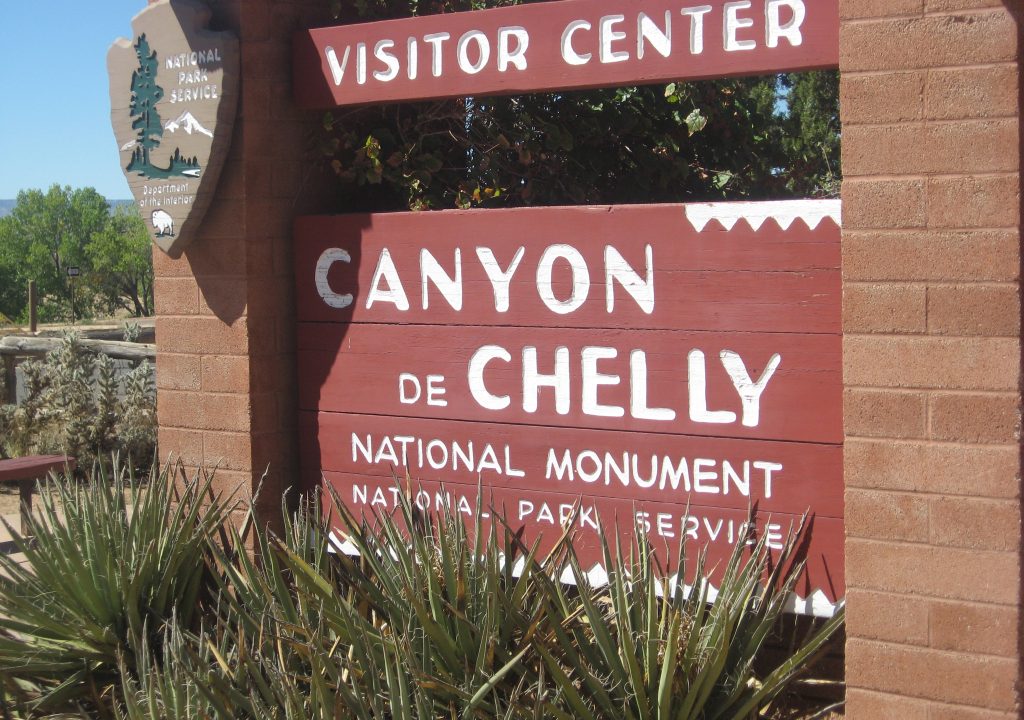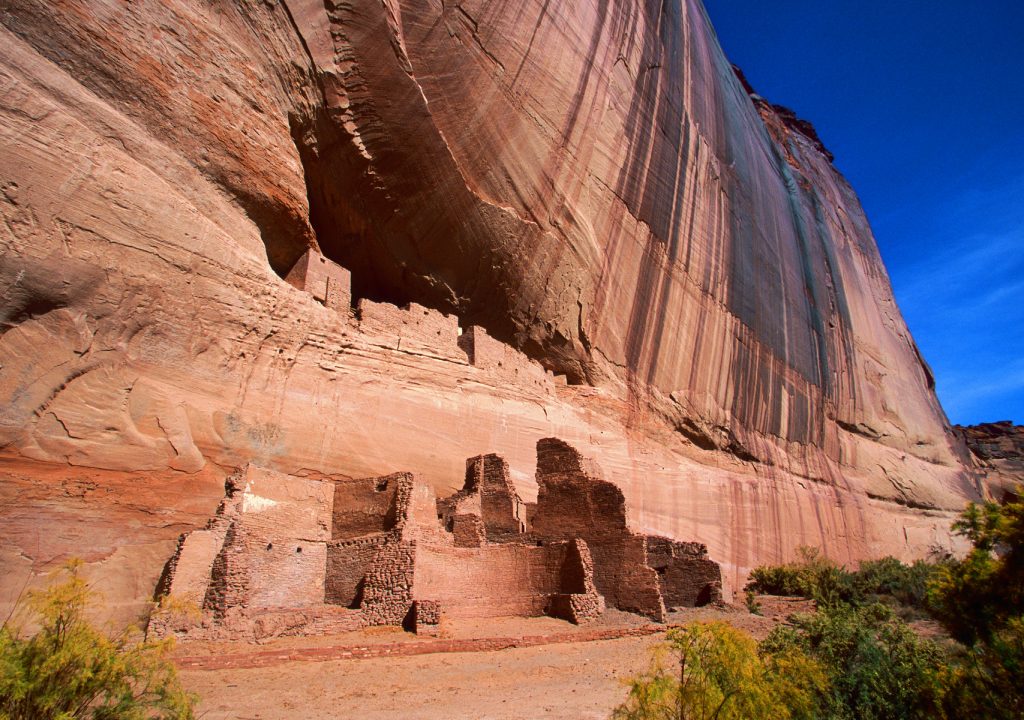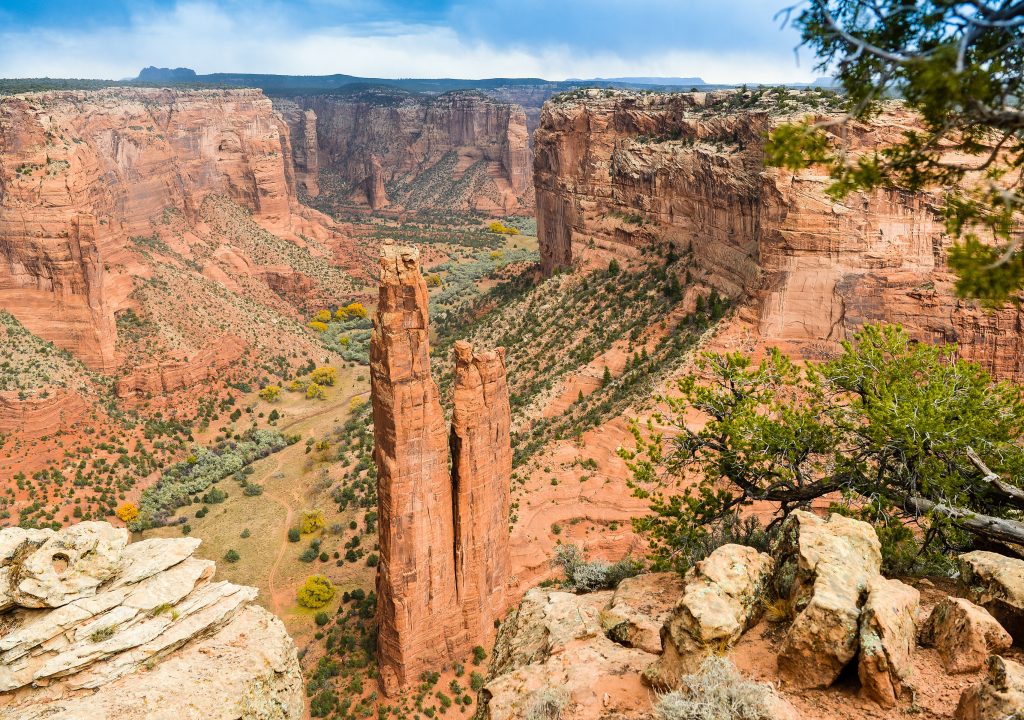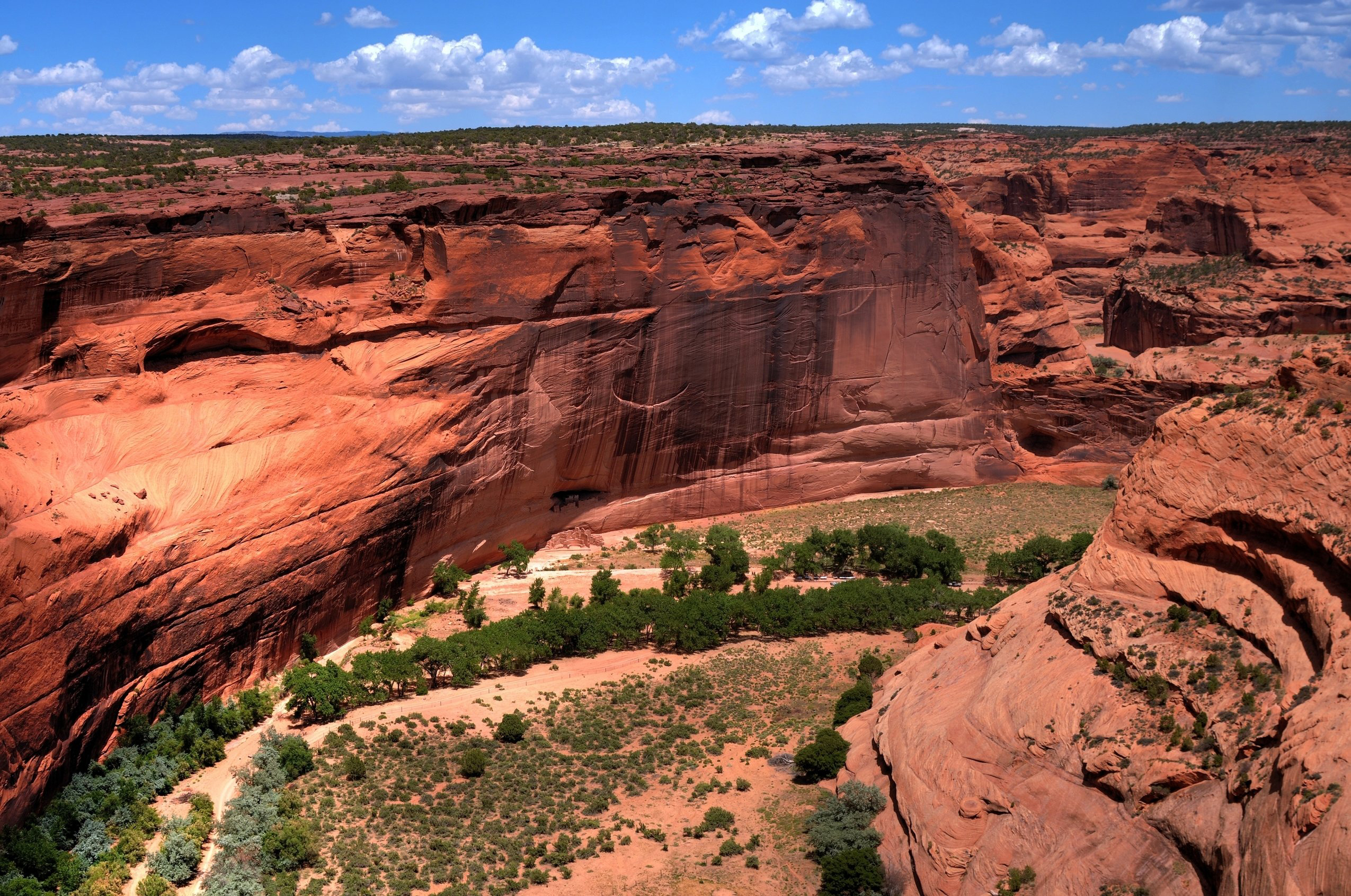Tourists visit Yellowstone National Park, Monument Valley, the Grand Canyon, Bryce, or Zion in droves – until now, Canyon de Chelly has been spared from hordes of visitors for the most part. While close to 5 million people visit the Grand Canyon annually, latest records indicate that just a couple hundred thousand included Canyon de Chelly on their trip of the Southwest. Quite surprising, given that the Canyon is less than a hundred miles from Monument Valley and can be reached in less than two hours. In Chinle, a few minutes by car outside the Canyon, there are many hotels, motels, restaurants, and fast food chains. For those who are backpacking or traveling by RV, the Cottonwood Campground is available. Backcountry camping or hiking is prohibited. Canyon de Chelly unjustly lives a wallflower existence. But that may be a good thing.
The Canyon was declared a National Monument in 1931, and since then bears the name Canyon de Chelly National Monument. “Canyon de Chelly” is a Navajo name that is pronounced “kɛnjən dəˈʃeɪ”, which fittingly translates to rock canyon. Although the land it is on belongs to the Navajo people, the monument has been managed by the National Park Service since the early 1930’s. In contrast to most national parks, national monuments do not require an entry fee. The monument is open year-round and closed on Christmas, Thanksgiving, and New Year’s Day.
People have lived in Canyon de Chelly for more than 5,000 years – longer than anyone has lived uninterrupted anywhere on the Colorado Plateau. Canyon de Chelly National Monument consists of “Canyon de Chelly”, “Canyon del Muerto”, and “Monument Canyon”, a total area of 131 square miles which is approx. the size of Las Vegas. With a length of over 24 miles, Canyon de Chelly is the longest of the three.

Before you head out to explore Canyon de Chelly, it is worth stopping at the visitor center, located directly at the entry to the monument. Here, you can get more information on weather forecasts, appropriate gear, available food, and accessible hiking trails from a ranger. With a little luck, you can watch Navajos practicing their craft. Canyon de Chelly is at an elevation of approx. 5,500 ft, and is still inhabited by the Navajo people, one of 15 Native American tribes based in Arizona. Like their ancestors, they raise livestock and cultivate grains and fruits. These areas of the Canyon are inaccessible to visitors unless you book a guided tour. Going into Canyon de Chelly requires a backcountry permit and a Navajo guide. Fees for this activity vary. Tours by car, horse, or on foot are generally available year-round, but may be limited due to thunderstorm warnings.
Driving along the North and South Rim Drives or hiking the White House Trail requires neither a backcountry permit, nor a Navajo guide. To visit the most impressive sights, you should preferably select the South Rim Drive. Roundtrip distance is approx. 37 miles. Plan on three hours to stop at all the viewpoints and to enjoy the majestic scenery and natural beauty.

Luckily, the White House Trail, 2.5 miles roundtrip with an elevation change of 600 ft., is open to the public. Hiking from the plateau deep into the interior of the canyon is highly recommended. The trail leads from the White House Overlook to the canyon floor; it is well developed, but rather steep in sections. Once you are at the bottom of the canyon, getting to the White House Ruins takes at least another 15 minutes. The White House Ruins are cliff dwellings built presumably about 1,000 years ago during the time of the Ancestral Puebloans, also called the Anasazi. The ruins are named after the white rock used to build the upper house. There is evidence of at least seasonal inhabitation of the canyon as early as 5,000 years ago. Unfortunately, the ruins can only be viewed from a safe distance and through a chain-linked fence. In the 1950’s, tourists climbed the ruin walls and defaced the historic site with their initials and other graffiti. Such misdeeds are now punishable with significant fines.
Canyon de Chelly has a colorful past. Approximately 700 years ago, Ancestral Puebloans who had lived there for several hundred years left the area due to disease and conflict with one another. Beginning around the year 1300, first the Hopi, then the Navajo and other tribes settled the canyon; they brought sheep and goats with them and cultivated crops on the canyon floor. Since Chinle Wash flows through Canyon de Chelly, irrigation was easy. The tended corn fields and peach orchards were therefore well renowned. In the later 1700’s, the peaceful seclusion ended abruptly through unrest among the tribes and the arrival of Spanish colonists. Some of the Navajos who had remained behind sought to hide in the jagged rocks, but could not avoid detection by the Spanish, Mexicans, and the US Calvary. Access to the canyon was sealed off and the fields destroyed, which ultimately led to a great famine. After the resistance was broken, the remaining Navajos were displaced or killed directly. Another dark chapter in the partly inglorious history of the United States during this time.

Another landmark in Canyon de Chelly is Spider Rock. Two giant red sandstone spires, visible from afar, that are approx. 230 million years old according to geologists and reach close to 800 ft. into the deep blue sky of Arizona. According to Native American mythology, the pinnacle of the rock is the home of Spider Woman. She taught the ancient people the art of weaving. Misbehaving children, on the other hand, were caught in her web and subsequently consumed.
Those who have planned their visit optimally should have time to return to the visitor center and then visit additional historic sites along the North Rim Drive. A site of sad notoriety is Massacre Cave in Canyon del Muerto. As you can tell from the name, this is the site of a one-sided, bloody slaughter that cost the lives of all 115 Navajos who had settled there. In the winter of 1805, a Spanish military expedition discovered a group of Native Americans on a hunt. The leader of the expedition, Lieutenant Antonio Narbona, had all the men killed and forced 33 women and children into slavery. Massacre Cave is also the place where a brave Navajo woman gained fame by jumping off a 1,000-ft. cliff to certain death while clinging to a Spanish officer.
Fortunately, the Canyon also experienced peaceful times, for example, on the big screen. The majestic natural backdrop did not escape the attention of Hollywood filmmakers. In 1969, under the direction of J. Lee Thompson, the western “Mackenna’s Gold” with Gregory Peck, Omar Sharif, Telly Savalas, and Edi Wallach in the starring roles, was filmed here.
Canyon de Chelly is a wonderfully quiet and remote destination, far removed from the hordes of tourists. Were it not for the parked rental cars at the overlooks and the Native American women selling their handcrafted jewelry wearing modern clothes, you would feel as though you were traveling through time. And if you are very quiet, with a little luck, you can hear the Navajo children laughing and playing. For the Navajo people, this place is still sacred.
Info
To get to Canyon de Chelly National Monument, it is best to fly into Phoenix, Arizona or Albuquerque, New Mexico and then continue via rental car.
From Phoenix, take Interstate 17 North to Flagstaff, where you get on Interstate 40 East. Stay on I-40 to Highway 191 North. From Albuquerque, take Interstate 40 West to Gallup. Take Highway 491 North and 264 West to Highway 191 North. Stay on Hwy 191 to Chinle.
Canyon de Chelly National Monument, 3 miles east of Highway 191 on Route 7, Chinle, AZ 86503
Tel.: 928-674-5500 * www.nps.gov/cach/index.htm
The visitor center is open daily from 8:00 am to 5:00 pm except Christmas, Thanksgiving, and New Year’s Day.
Please remember that you are not allowed to photograph Native Americans or their private homes and villages. However, if you ask beforehand, they are often willing to be photographed in return for a small donation.





